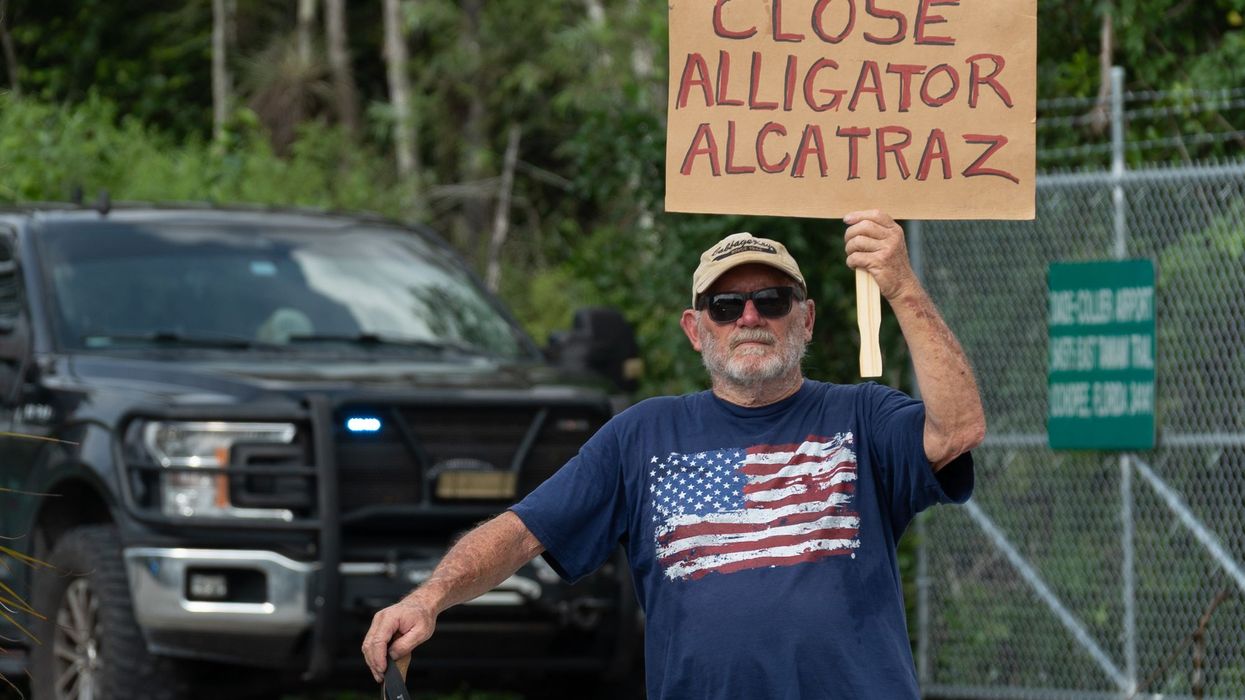January, 05 2021, 11:00pm EDT

Lawsuit Launched to Protect Eight Florida Plants Threatened by Sea-level Rise, Development
Badly needed habitat protection delayed by Trump Administration.
ST. PETERSBURG, Fla
The Center for Biological Diversity filed a formal notice today of its intent to sue the U.S. Fish and Wildlife Service over the agency's failure to designate critical habitat for eight Florida plants, including one called the Everglades bully and a flowering shrub found only in the lower Florida Keys.
The species named in today's notice are the Big Pine partridge pea, Blodgett's wild mercury, sand flax, wedge spurge, Everglades bully, Florida pineland crabgrass, Florida prairie-clover and pineland sandmat.
The Center previously sued the Service to protect these plants, several of which had been waiting decades for protection. As a result of a historic settlement agreement with the Obama administration, they were listed in 2017 and 2018, meaning that protection of critical habitat is now years overdue.
"Florida's plants play a vital role in sustaining Florida's biodiversity and beauty," said Jaclyn Lopez, Florida director of the Center. "Federally designated critical habitat will help these plants rebound."
With only 25 species protected as threatened or endangered, delay and denial of habitat protections and significant regulatory rollbacks, the Trump administration has the worst record protecting species of any administration since Congress passed the Endangered Species Act.
The Endangered Species Act prohibits federal agencies from authorizing activities that will destroy or harm a listed species' critical habitat. Species with federally protected critical habitat are more than twice as likely to be recovering as species without it.
"Habitat loss is the biggest cause of extinction," said Lopez. "We're not going to be able to save these remarkable native plants without protecting the places they live."
Earlier this year the Center filed suit in Washington, D.C. over more than 200 species from the workplan that await decisions. In addition to the eight species included in today's notice, the Center plans to initiate lawsuits for another 20 species waiting for listing and 81 species waiting for designation of critical habitat and hopes to work out a schedule with the Biden administration to ensure these species from across the country get protection and avoid extinction.
The Center filed a separate notice yesterday of its intent to sue outgoing Interior Secretary David Bernhardt for delaying protection for 11 species, including the monarch butterfly and northern spotted owl, that have been identified as warranting endangered status but placed on a candidate list instead.
Species Highlights
Big Pine partridge pea: The Big Pine partridge pea is a small shrub with five-petal, yellow flowers and pea-shaped fruit. It is found only in the pine rocklands of the lower Florida Keys, historically Big Pine Key, No Name Key, Ramrod Key, Cudjoe Key and Sugarloaf Key. The plant is now only found on Big Pine Key and Cudjoe Key.
Wedge spurge: The wedge spurge is a small, perennial herb with slender stems and a silvery appearance. It occurs in pine rocklands and roadsides on Big Pine Key, where its population is declining.
Sand flax: The sand flax is a small, perennial herb with yellow, buttercup-looking flowers. It is found in pine rocklands in Monroe and Miami-Dade counties, and its populations are declining.
Blodgett's silverbush: The Blodgett's silverbush is a woody shrub with small, green flowers. It grows in the pine rocklands of Monroe and Miami-Dade counties, but has become increasingly rare.
Everglades bully: The Everglades bully had been a candidate for protection since 2004. The shrub is native to Miami-Dade County and is only found in pine rocklands.
Florida pineland crabgrass: The Florida pineland crabgrass is also known as Everglades grass or twospike crabgrass, and only occurs in the Everglades in Miami-Dade and Monroe counties. It was first identified as needing endangered species protection in 1975; the Center petitioned the Service to protect it in 2004.
Florida prairie clover: The Florida prairie clover had been waiting on the agency's candidate list for federal protection since 1999. It's a member of the pea family and grows up to 6 feet tall in pine rocklands and coastal uplands.
Pinelands sandmat: The Pinelands sandmat had been a candidate for protection since 1999. Also known as the pineland deltoid spurge, rockland spurge and wedge sandmat, it's a beautiful perennial herb with a red stem and delicate, yellow flowers.
At the Center for Biological Diversity, we believe that the welfare of human beings is deeply linked to nature — to the existence in our world of a vast diversity of wild animals and plants. Because diversity has intrinsic value, and because its loss impoverishes society, we work to secure a future for all species, great and small, hovering on the brink of extinction. We do so through science, law and creative media, with a focus on protecting the lands, waters and climate that species need to survive.
(520) 623-5252LATEST NEWS
'A Human Rights Disaster': Report Details Torture and Chaos at 'Alligator Alcatraz'
Conditions at Florida detention facilities "represent a deliberate system of cruelty designed to punish people seeking to build a new life in the US,” said an official at Amnesty International.
Dec 04, 2025
Two immigration detention centers in Florida have gained notoriety for inhumane conditions since Republican Gov. Ron DeSantis, in close alignment with President Donald Trump's anti-immigrant agenda, has rapidly scaled up mass detention in the state, and a report released Thursday detailed how human rights violations at the two facilities amount to torture in some cases.
Amnesty International published the report, Torture and Enforced Disappearances in the Sunshine State, with a focus on Krome North Service Processing Center and the Everglades Detention Facility, also known by its nickname, "Alligator Alcatraz."
As Common Dreams has reported, many of the people detained at the facilities have been arbitrarily rounded up by immigration agents, with a majority of the roughly 1,000 people being held at Alligator Alcatraz having been convicted of no criminal offense as of July.
Amnesty's report described unsanitary conditions, with fecal matter overflowing from toilets in detainees' sleeping areas, authorities granting only limited access to showers, and poor quality food and water.
Some of the treatment amounts to torture, the report says, including Alligator Alcatraz's use of "the box"—a 2x2 foot "cage-like structure people are put in as punishment—which inmates have been placed in for hours at a time with their hands and feet attached to restraints on the ground.
“These despicable and nauseating conditions at Alligator Alcatraz reflect a pattern of deliberate neglect designed to dehumanize and punish those detained there,” said Amy Fischer, director of refugee and migrant rights with Amnesty International USA. “This is unreal—where’s the oversight?”
At Krome, detainees have been arbitrarily placed in prolonged solitary confinement—defined as lasting longer than 15 days—which is prohibited under international law.
"The use of prolonged solitary confinement at Krome and the use of the ‘box’ at 'Alligator Alcatraz' amount to torture or other ill-treatment," said Amnesty.
The report elevates concerns raised in September by immigrant rights advocates regarding the lack of federal oversight at Alligator Alcatraz, with nearly 1,000 men detained at the prison having been "administratively disappeared"—their names absent from US Immigration and Customs Enforcement's detainee locator system.
"The absence of registration or tracking mechanisms for those detained at Alligator Alcatraz facilitates incommunicado detention and constitutes enforced disappearances when the whereabouts of a person being detained there is denied to their family, and they are not allowed to contact their lawyer," said Amnesty.
The state of Florida has not publicly confirmed the number of people detained at Alligator Alcatraz.
One man told Amnesty, "My lawyers tried to visit me, but they weren’t let in. They were told that they had to fill out a form, which they did, but nothing happened. I was never able to speak with them confidentially.”
At Krome, detainees described overcrowding, medical neglect, and abuse by guards when Amnesty researchers visited in September. ICE has constructed tents and other semi-permanent structures to hold more people than the facility is designed to detain.
The Amnesty researchers were given a tour of relatively extensive medical facilities at Krome, including a dialysis clinic, dental clinic, and a "state-of-the-art" mental health facility—but despite these resources, detainees described officials' failure to provide medical treatment and delays in health assessments. Four people—Ramesh Amechand, Genry Ruiz Guillen, Maksym Chernyak, and Isidro Pérez—have died this year while detained at Krome.
"It’s a disaster if you want to see the doctor," one man told Amnesty. "I once asked to see the doctor, and it took two weeks for me to finally see him. It’s very slow.”
Researchers with the organization witnessed "a guard violently slam a metal flap of a door to a solitary confinement room against a man’s injured hand," and people reported being "hit and punched" by officials at Krome.
In line with the Trump administration, DeSantis and Republican state lawmakers have sought to make Florida "a testing ground for abusive immigration enforcement policies," said Amnesty, with the state deputizing local law enforcement to make immigration arrests and issuing 34 no-bid contracts totaling more than $360 million for the operation of Alligator Alcatraz—while slashing spending on healthcare, food assistance, and disaster relief. Florida has increased the number of people in immigration detention by more than 50% since Trump took office in January.
The organization called on Florida to redirect detention funding toward healthcare, housing, and other public spending, and to ban "shackling, solitary confinement, and punitive outdoor confinement" in line with international standards.
"At the federal level, the US government must end its cruel mass immigration detention machine, stop the criminalization of migration, and bar the use of state-owned facilities for federal immigration custody," said Amnesty.
Fischer emphasized that the chaotic and abusive conditions Amnesty observed at Alligator Alcatraz and Krome "are not isolated."
"They represent a deliberate system of cruelty designed to punish people seeking to build a new life in the US,” said Fischer. “We must stop detaining our immigrant community members and people seeking safety and instead work toward humane, rights-respecting migration policies.”
Keep ReadingShow Less
'Pro-White Collar Crime': Trump Pardons Former Executive Indicted by His Own DOJ
"This president serves the ultra-wealthy—not working people," said one watchdog group.
Dec 04, 2025
US President Donald Trump on Wednesday granted a full, unconditional pardon to former entertainment venue executive Tim Leiweke, who was indicted just months ago by Trump's own Justice Department for "orchestrating a conspiracy to rig the bidding process for an arena at a public university."
Leiweke, who expressed "profound gratitude" for the pardon, stepped down as CEO of Oak View Group in July, on the same day that the Justice Department’s Antitrust Division announced the indictment.
The longtime sports executive was accused of conspiring with the CEO of a competitor to rig bidding for the development of the $375 million, 15,000-seat Moody Center at the University of Texas at Austin. Assistant Attorney General Abigail Slater said the scheme "deprived a public university and taxpayers of the benefits of competitive bidding."
Leiweke pleaded not guilty to the charge, which carried a maximum prison sentence of 10 years.
Bloomberg observed that the pardon comes "just before Leiweke is scheduled to be deposed by lawyers for the Justice Department and Live Nation Entertainment Inc. on Thursday in the DOJ’s separate civil antitrust case against the company and its subsidiary Ticketmaster."
"Leiweke earlier unsuccessfully tried to avoid the deposition, citing liability from then pending criminal charges, according to court records," Bloomberg added.
Federal investigators have accused Oak View Group, Leiweke's former company, of quietly receiving kickbacks for promoting Ticketmaster services at Oak View Group venues.
The pardon was announced on the same day that Trump granted clemency to US Rep. Henry Cuellar (D-Texas), who faced bribery and money laundering charges. Days earlier, the president commuted the prison sentence of a former private equity executive convicted of defrauding more than 10,000 investors.
"Private equity CEO David Gentile was sentenced to seven years for defrauding investors of 1.6 BILLION," the watchdog group Public Citizen wrote Wednesday. "But Trump commuted his sentence. This isn't the first time Trump has helped the corporate class evade accountability. This president serves the ultra-wealthy—not working people."
Antitrust advocate Matt Stoller accused Trump of advancing a "straightforward pro-white collar crime agenda" by using his pardon power to rescue fraudsters from prison time.
"Trump's pro-white collar crime agenda seems pretty open at this point," Stoller wrote in response to the Cuellar pardon.
As the New York Times reported earlier this year, Trump has employed "the vast power of his office to redefine criminality to suit his needs—using pardons to inoculate criminals he happens to like, downplaying corruption and fraud as crimes, and seeking to stigmatize political opponents by labeling them criminals."
"An offshoot of this strategy is relegating white-collar offenses to a rank of secondary importance behind violent and property crimes," the Times noted. "He has even tried to create a new red-alert category—what he calls 'immigrant crime,' even though studies have shown that immigrants are not more likely to commit violent offenses than people born in the country."
Keep ReadingShow Less
Trump Regulators Ripped for 'Rushed' Approval of Bill Gates' Nuclear Reactor in Wyoming
"Make no mistake, this type of reactor has major safety flaws compared to conventional nuclear reactors that comprise the operating fleet," said one expert.
Dec 03, 2025
A leading nuclear safety expert sounded the alarm Tuesday over the Trump administration's expedited safety review of an experimental nuclear reactor in Wyoming designed by a company co-founded by tech billionaire Bill Gates and derided as a "Cowboy Chernobyl."
On Monday, the US Nuclear Regulatory Commission (NRC) announced that it has "completed its final safety evaluation" for Power Station Unit 1 of TerraPower's Natrium reactor in Kemmerer, Wyoming, adding that it found "no safety aspects that would preclude issuing the construction permit."
Co-founded by Microsoft's Gates, TerraPower received a 50-50 cost-share grant for up to $2 billion from the US Department of Energy’s Advanced Reactor Demonstration Program. The 345-megawatt sodium-cooled small modular reactor (SMR) relies upon so-called passive safety features that experts argue could potentially make nuclear accidents worse.
However, federal regulators "are loosening safety and security requirements for SMRs in ways which could cancel out any safety benefits from passive features," according to Union of Concerned Scientists nuclear power safety director Edwin Lyman.
"The only way they could pull this off is by sweeping difficult safety issues under the rug."
The reactor’s construction permit application—which was submitted in March 2024—was originally scheduled for August 2026 completion but was expedited amid political pressure from the Trump administration and Congress in order to comply with an 18-month timeline established in President Donald Trump’s Executive Order 14300.
“The NRC’s rush to complete the Kemmerer plant’s safety evaluation to meet the recklessly abbreviated schedule dictated by President Trump represents a complete abandonment of its obligation to protect public health, safety, and the environment from catastrophic nuclear power plant accidents or terrorist attacks," Lyman said in a statement Tuesday.
Lyman continued:
The only way the staff could finish its review on such a short timeline is by sweeping serious unresolved safety issues under the rug or deferring consideration of them until TerraPower applies for an operating license, at which point it may be too late to correct any problems. Make no mistake, this type of reactor has major safety flaws compared to conventional nuclear reactors that comprise the operating fleet. Its liquid sodium coolant can catch fire, and the reactor has inherent instabilities that could lead to a rapid and uncontrolled increase in power, causing damage to the reactor’s hot and highly radioactive nuclear fuel.
Of particular concern, NRC staff has assented to a design that lacks a physical containment structure to reduce the release of radioactive materials into the environment if a core melt occurs. TerraPower argues that the reactor has a so-called "functional" containment that eliminates the need for a real containment structure. But the NRC staff plainly states that it "did not come to a final determination of the adequacy and acceptability of functional containment performance due to the preliminary nature of the design and analysis."
"Even if the NRC determines later that the functional containment is inadequate, it would be utterly impractical to retrofit the design and build a physical containment after construction has begun," Lyman added. "The potential for rapid power excursions and the lack of a real containment make the Kemmerer plant a true ‘Cowboy Chernobyl.’”
The proposed reactor still faces additional hurdles before construction can begin, including a final environmental impact assessment. However, given the Trump administration's dramatic regulatory rollback, approval and construction are highly likely.
Former NRC officials have voiced alarm over the Trump administration's tightened control over the agency, which include compelling it to send proposed reactor safety rules to the White House for review and possible editing.
Allison Macfarlane, who was nominated to head the NRC during the Obama administration, said earlier this year that Trump's approach marks “the end of independence of the agency.”
“If you aren’t independent of political and industry influence, then you are at risk of an accident,” she warned.
Keep ReadingShow Less
Most Popular


